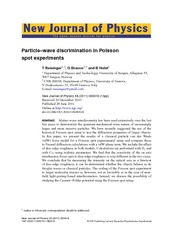Particle–wave discrimination in Poisson spot experiments
Peer reviewed, Journal article
Published version
Permanent lenke
https://hdl.handle.net/1956/5036Utgivelsesdato
2011Metadata
Vis full innførselSamlinger
Originalversjon
https://doi.org/10.1088/1367-2630/13/6/065016Sammendrag
Matter–wave interferometry has been used extensively over the last few years to demonstrate the quantum-mechanical wave nature of increasingly larger and more massive particles. We have recently suggested the use of the historical Poisson spot setup to test the diffraction properties of larger objects. In this paper, we present the results of a classical particle van der Waals (vdW) force model for a Poisson spot experimental setup and compare these to Fresnel diffraction calculations with a vdW phase term. We include the effect of disc-edge roughness in both models. Calculations are performed with D2 and with C70 using realistic parameters. We find that the sensitivity of the on-axis interference/focus spot to disc-edge roughness is very different in the two cases. We conclude that by measuring the intensity on the optical axis as a function of disc-edge roughness, it can be determined whether the objects behave as de Broglie waves or classical particles. The scaling of the Poisson spot experiment to larger molecular masses is, however, not as favorable as in the case of nearfield light-grating-based interferometers. Instead, we discuss the possibility of studying the Casimir–Polder potential using the Poisson spot setup.

